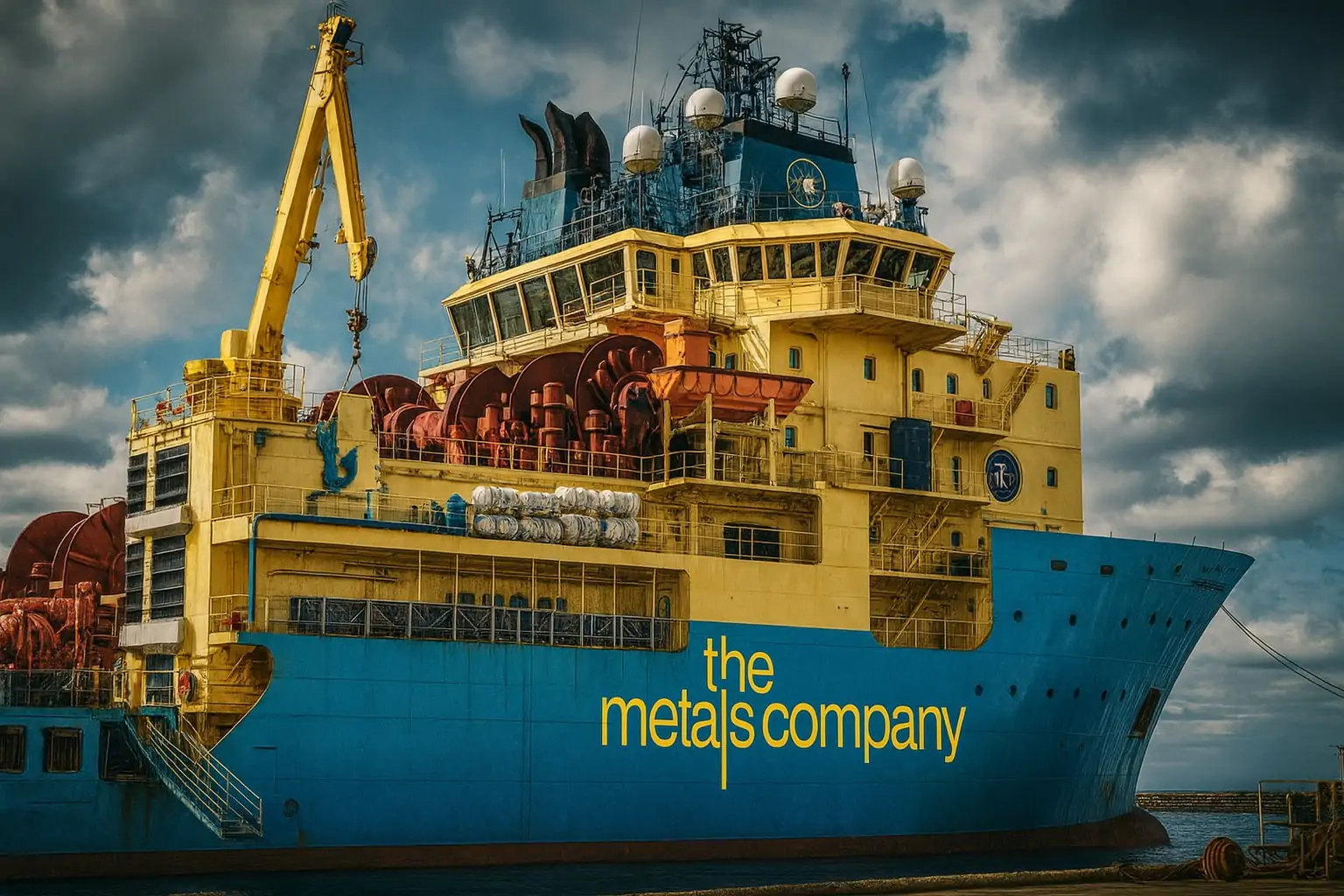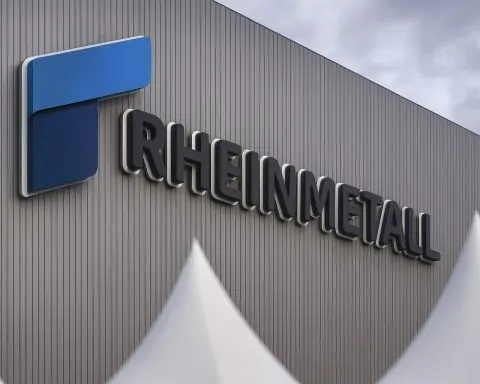- TMC stock is back in the spotlight after a sharp after‑hours move: shares jumped 7.38% to $5.82 in Tuesday’s session following already strong gains in regular trading. [1]
- The move follows Q3 2025 results showing a large net loss but a much stronger balance sheet, with $121 million in cash and roughly $165 million in total liquidity, and a management statement that the company has “no need to come to the public markets anytime soon.” [2]
- All four metals in TMC’s polymetallic nodules – nickel, cobalt, manganese and now copper – are officially on the U.S. Critical Minerals List, after copper was added in the November 2025 update, strengthening TMC’s strategic narrative. [3]
- The company continues to advance a world‑first deep‑sea mining project: economic studies value the NORI‑D project at $23.6 billion with a $5.5 billion NPV and 51 million tonnes of probable reserves, with targeted commercial production in Q4 2027 if permits are granted. [4]
- At the same time, regulatory and environmental risks remain high, with UN bodies, scientists and NGOs warning about long‑term seabed damage and contested international legal ground for U.S.‑backed mining in international waters. [5]
TMC stock today: from after‑hours spike to ongoing volatility
TMC the metals company Inc. (NASDAQ:TMC), the deep‑sea minerals developer targeting polymetallic nodules in the Pacific’s Clarion‑Clipperton Zone (CCZ), is again one of the market’s most volatile tickers.
According to Benzinga’s overnight coverage (republished via inkl), TMC shares closed Tuesday at $5.42, up 10.95% on the day, before jumping another 7.38% in after‑hours trading to $5.82. [6] CoinCentral and Blockonomi ran parallel pieces on Wednesday highlighting the same after‑hours rally. [7]
Market data from StockAnalysis shows that TMC finished Tuesday’s regular session at $5.42, up about 11% on the day, with a 52‑week range of $0.72 to $11.35. [8] As of late Wednesday (19 November), real‑time quotes still show the stock trading around $5.42, roughly 11% above its previous close, underlining how elevated the name remains even after intraday swings.
Over the last year, the stock has been on an extraordinary run: Benzinga and CoinCentral both note that TMC is up roughly 350% year‑to‑date and about 500% over the past 12 months, with a market capitalisation in the $2.1–$2.3 billion range. [9]
That kind of performance, coming from a pre‑revenue company that has yet to receive final mining permits, is exactly why TMC has become one of 2025’s most hotly debated speculative plays.
Why is TMC trending? The story behind the latest move
Across Wednesday’s coverage, financial and crypto‑adjacent outlets are largely telling the same story: the latest surge is less about a sudden new announcement and more about investors digesting a cluster of positive developments that accumulated over the last few months.
1. Stronger balance sheet and “no need” for near‑term equity raises
In its Q3 2025 corporate update last week, TMC reported: [10]
- Total cash: about $115.6 million as of 30 September 2025
- Cash used in operations (Q3): $11.5 million
- Operating loss (Q3): $55.4 million
- Net loss (Q3): $184.5 million, or $0.46 per share
Those headline numbers underscore just how capital‑intensive TMC’s project is – but the market seems more focused on what happened after the quarter ended. CEO Gerard Barron told investors that, after warrant exercises and access to undrawn credit facilities, cash on the balance sheet stood at about $121 million and total liquidity at roughly $165 million. [11]
Crucially, Barron said the company has “no need to come to the public markets anytime soon,” a line highlighted in both Benzinga and CoinCentral’s summaries and widely interpreted as an attempt to ease fears of near‑term dilution. [12]
For a stock where previous capital raises were a major overhang, that messaging appears to be one of the main catalysts behind the recent buying.
2. All four nodule metals now “critical” in the U.S.
Another theme running through today’s coverage is the policy tailwind from Washington.
On 7 November, the U.S. Department of the Interior released its final 2025 List of Critical Minerals, adding 10 commodities – including copper, silver, lead and uranium – to a roster of materials deemed vital to U.S. economic and national security interests. [13]
Because TMC’s polymetallic nodules contain nickel, cobalt, manganese and copper, the addition of copper means that all four of the company’s target metals now carry “critical” status in the U.S. [14]
TMC’s own Q3 update notes that, under the company’s pre‑feasibility study (PFS), copper accounts for about 17% of expected life‑of‑mine revenue, so the critical designation is not just symbolic. [15] Being on the list can influence federal permitting priorities, strategic stockpiling, financing tools and tariffs, and it reinforces the narrative that TMC’s resource could fit squarely into U.S. efforts to reduce reliance on Chinese‑controlled supply chains. [16]
CoinCentral and Blockonomi both frame this as a key driver of the after‑hours rally, arguing that the critical‑minerals angle boosts the perceived strategic value of TMC’s offshore project. [17]
3. Economic studies value project at $23.6 billion
Back in August, TMC released two technical economic assessments for its flagship NORI‑D area, prepared under the SEC’s SK‑1300 framework. Those studies: [18]
- Assigned a combined project value of $23.6 billion across TMC’s areas
- Delivered a PFS NPV of $5.5 billion for NORI‑D
- Included what TMC calls the world’s first declaration of mineral reserves for a polymetallic nodule project, with 51 million tonnes of probable reserves
- Envision commercial production starting in Q4 2027, contingent on securing a commercial recovery permit
Benzinga, CoinCentral and Blockonomi all revisit these numbers in today’s pieces, arguing that investors may be increasingly willing to underwrite long‑dated cash flows as regulatory progress improves and the macro backdrop for critical minerals tightens. [19]
4. Regulatory momentum: NOAA rule and U.S. seabed permitting
From a regulatory standpoint, two developments stand out:
- U.S. seabed mining rule moves to the White House
On 30 October, Politico reported – and TMC reiterated in its Q3 update – that NOAA had sent a draft deep‑sea mining rule to the White House. The rule would consolidate and streamline licensing and permitting, allowing companies to apply simultaneously for exploration licenses and commercial recovery permits under the 1980 Deep Seabed Hard Mineral Resources Act (DSHMRA). [20] - TMC USA gets full compliance notice from NOAA
TMC’s U.S. subsidiary, The Metals Company USA LLC, received a notice of full compliance from NOAA in August for its exploration license applications, including priority rights over both exploration areas. Those applications are now in the certification phase, following earlier “substantial compliance” findings in May. [21]
Together with April’s executive order “Unleashing America’s Offshore Critical Minerals and Resources”, which directs agencies to expedite offshore critical minerals permitting, these steps are widely seen as the backbone of a new U.S.‑centric path to deep‑sea mining. [22]
For TMC, which is simultaneously pursuing a more contentious route through the U.N.‑backed International Seabed Authority (ISA), this dual‑track regulatory strategy is central to its investment case – and a major source of both optimism and controversy.
Under the hood: Q3 2025 shows a bigger loss and bigger ambitions
While the stock’s momentum has grabbed headlines, the underlying financials are still those of a company in early‑stage development.
Q3 2025 by the numbers
According to TMC’s Q3 release: [23]
- Cash (30 Sept 2025): $115.6 million
- Operating loss (Q3): $55.4 million
- Net loss (Q3): $184.5 million
- Net loss per share (Q3): $0.46
- Cash used in operations (Q3): $11.5 million
The jump in net loss was driven largely by non‑cash and non‑recurring items, including:
- A $131 million increase in the fair value of the company’s royalty liability after the new economic studies
- Warrant costs tied to updated sponsorship agreements with Nauru and Tonga
- A sharp rise in share‑based compensation for directors, employees and consultants
Exploration and evaluation expenses actually fell year‑on‑year, as the company wound down a previous offshore campaign and nodule transport program. [24]
An analysis from Simply Wall St, published Tuesday, underscores the tension: TMC remains pre‑revenue, posted a net loss of roughly $184.5 million in Q3 alone, and has accumulated a deficit of over $900 million – yet continues to attract speculative capital on the promise of future cash flows. [25]
Technology progress: battery‑grade manganese sulfate
Beyond the balance sheet, TMC points to onshore processing breakthroughs. In October, the company produced battery‑grade manganese sulfate from nodule‑derived intermediate material in bench‑scale trials at Kingston Process Metallurgy in Ontario. [26]
Manganese sulfate is a key precursor for certain EV battery cathode chemistries, and North America is currently heavily dependent on overseas processing capacity. TMC argues that its nodules – which it describes as “the planet’s largest source of manganese” – could support domestic supply chains for steel, batteries, energy and defense applications if processing can be scaled economically and responsibly. [27]
How Wall Street and options traders are reading TMC
Analysts: mixed signals and shifting targets
New analysis from MarketBeat on Tuesday notes that Wedbush cut its FY2028 EPS estimate for TMC to $0.33 from $0.36, even as the consensus forecast for current‑year earnings remains deeply negative at –$0.22 per share. [28]
The same piece highlights an increasingly divided analyst community:
- HC Wainwright recently raised its price target to $7.50 with a “buy” rating
- Weiss Ratings maintains a “sell (D‑)” view
- Zacks lifted its stance from “strong sell” to “hold”
MarketBeat characterises the net result as an average rating of “Hold” with a consensus price target around $7.42, versus a share price near $5–6. [29]
By contrast, StockAnalysis aggregates four analysts into a “Strong Buy” consensus with a 12‑month target price of $6.94, while Investing.com quotes an even higher average target of roughly $8.8 based on five analysts – implying upside of more than 60% from current levels. [30]
The discrepancy illustrates just how uncertain and model‑dependent TMC’s valuation is at this stage.
Options and technicals: volatility as a feature, not a bug
TipRanks’ auto‑generated “Why TMC Shares Are Rising” note on Wednesday points to bullish options activity and rising implied volatility, with its internal model flashing a “Buy” technical sentiment signal. [31]
CoinCentral also flags elevated options volume and implied volatility, suggesting that speculative trading – not just long‑term fundamental investors – is driving much of the recent price action. [32]
Separately, MarketBeat’s short‑interest tracker (cited earlier this week) shows around 25 million shares sold short, a heavy level for a company of TMC’s size, which traders say can amplify both rallies and sell‑offs when news hits. [33]
Deep‑sea mining’s unresolved risks: law, science and backlash
Even as Wednesday’s headlines focus on liquidity, critical minerals and regulatory progress, TMC’s business model remains entangled in unresolved legal and environmental questions.
Legal and geopolitical questions
TMC’s April 29 press release detailed a “world‑first” application for a commercial recovery permit and two exploration licenses under the U.S. seabed mining code, submitted by its U.S. subsidiary TMC USA shortly after Trump’s executive order on offshore critical minerals. [34]
However:
- The United States has not ratified the U.N. Convention on the Law of the Sea and is not a member of the ISA, the body traditionally expected to regulate mining in areas beyond national jurisdiction. [35]
- Critics argue that a purely U.S.‑based framework for mining in international waters could clash with international law and invite diplomatic and legal challenges from other nations and NGOs. [36]
An Associated Press report earlier this year described TMC’s move to seek U.S. approval as an effort to “sidestep the authority” of the ISA, warning that any unilateral green‑light from Washington may not resolve, and could even deepen, international disputes over who has the right to mine the global seabed. [37]
Environmental science and calls for a moratorium
On the environmental side, multiple scientific studies and U.N.‑linked reviews have raised concerns that disturbance to deep‑sea ecosystems could be long‑lasting or effectively irreversible:
- One long‑term study of a Pacific seabed test‑mining area found that impacts were still evident after more than 40 years, giving ammunition to campaigners pushing for a global moratorium. [38]
- Environmental groups, some Pacific Island states and a broad coalition of scientists have urged the ISA to delay issuing exploitation licenses until more is known about ecological risks. [39]
TMC, for its part, insists that its own decade‑plus environmental research program shows impacts will be “minimal and manageable” at commercial scale, pointing to an expanding dataset and modelling work. [40]
The gap between those views is unlikely to close quickly – and it remains a core risk factor for any long‑term outlook on the stock.
What today’s move means for investors
With TMC once again trending across financial media on 19 November, the bull‑bear divide looks sharper than ever.
The bullish narrative
Supporters of TMC tend to emphasise:
- Strategic tailwinds: all four nodule metals now carry U.S. “critical” status, aligning TMC squarely with U.S. industrial and security goals. [41]
- Regulatory momentum: NOAA’s draft rule at the White House, full‑compliance notices for TMC USA, and a series of executive orders encouraging deep‑sea minerals. [42]
- De‑risking milestones: SK‑1300‑compliant PFS and reserve declaration, plus bench‑scale production of battery‑grade manganese sulfate. [43]
- Improved liquidity: a cash position north of $120 million and total liquidity around $165 million, reducing near‑term dilution fears. [44]
- Momentum and optionality: a five‑fold 12‑month share price gain, heavy options activity, and analyst targets implying further upside if the project executes. [45]
The bearish narrative
Skeptics counter with an equally long list:
- No current operating revenue and a Q3 net loss of $184.5 million, on top of a multi‑hundred‑million‑dollar accumulated deficit. [46]
- Negative equity and a capital structure sensitive to changes in royalty and warrant valuations. [47]
- Unproven commercial technology at industrial scale, from offshore collection systems to onshore processing and refining. [48]
- Regulatory uncertainty, with TMC navigating both U.S. and ISA frameworks amid geopolitical tension and vocal opposition. [49]
- Environmental risk and reputational blowback, where further scientific evidence or political shifts could delay or block exploitation. [50]
- Valuation risk, highlighted by MarketBeat’s “Hold” consensus, the recent cut to long‑term EPS forecasts and warnings from some analysts and bloggers that the stock may already be pricing in very optimistic scenarios. [51]
In short, TMC remains a high‑beta, high‑conviction story: potentially transformative if everything goes right, but heavily exposed to regulatory, scientific and execution setbacks.
Looking ahead: key catalysts to watch
For readers tracking TMC into year‑end and beyond, several potential catalysts stand out:
- Progress on NOAA’s deep‑sea mining rule and any subsequent decisions on TMC USA’s exploration licenses and commercial recovery permit. [52]
- Further clarification of ISA timelines and positions on deep‑sea mining regulations, including responses to growing calls for a moratorium. [53]
- Updates on onshore processing trials, especially any move from bench‑scale to pilot or demonstration‑scale production of battery‑grade materials. [54]
- Financing developments, particularly if capex estimates for the full NORI‑D project and associated processing facilities become clearer. [55]
- Next earnings and corporate update, currently expected in March 2026, which will shed light on cash burn, permitting progress and any changes in strategic partnerships. [56]
For now, 19 November 2025 finds TMC at a familiar crossroads: celebrated as a flagship of the critical‑minerals and U.S. energy‑security theme, yet still years away from commercial production and surrounded by scientific, legal and ethical questions.
Important note
This article is journalistic in nature and does not constitute financial advice or a recommendation to buy or sell any security. Deep‑sea mining is a complex and evolving area; anyone considering an investment in TMC should perform their own research, read the company’s SEC filings and risk factors, and consider speaking with a qualified financial adviser.
References
1. www.inkl.com, 2. investors.metals.co, 3. investors.metals.co, 4. investors.metals.co, 5. www.reuters.com, 6. www.inkl.com, 7. coincentral.com, 8. stockanalysis.com, 9. www.inkl.com, 10. investors.metals.co, 11. investors.metals.co, 12. coincentral.com, 13. www.usgs.gov, 14. investors.metals.co, 15. investors.metals.co, 16. www.usgs.gov, 17. coincentral.com, 18. investors.metals.co, 19. www.inkl.com, 20. investors.metals.co, 21. investors.metals.co, 22. www.whitehouse.gov, 23. investors.metals.co, 24. investors.metals.co, 25. simplywall.st, 26. investors.metals.co, 27. investors.metals.co, 28. www.marketbeat.com, 29. www.marketbeat.com, 30. stockanalysis.com, 31. www.tipranks.com, 32. coincentral.com, 33. www.marketbeat.com, 34. investors.metals.co, 35. www.reuters.com, 36. apnews.com, 37. apnews.com, 38. www.reuters.com, 39. www.reuters.com, 40. investors.metals.co, 41. investors.metals.co, 42. investors.metals.co, 43. investors.metals.co, 44. investors.metals.co, 45. coincentral.com, 46. investors.metals.co, 47. investors.metals.co, 48. investors.metals.co, 49. www.reuters.com, 50. www.reuters.com, 51. www.marketbeat.com, 52. www.eenews.net, 53. www.reuters.com, 54. investors.metals.co, 55. investors.metals.co, 56. www.investing.com







